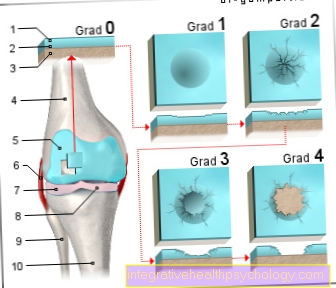Respiratory acidosis
definition
Respiratory acidosis is a change in the pH value in the blood towards the acidic range. The normal pH of the blood fluctuates between 7.38-7.45. If there is respiratory acidosis, the pH value drops.
As the name suggests, the presence of respiratory acidosis is due to a breathing disorder. The patient is hypoventilated, which means he is breathing less than normal. However, balanced breathing is essential to maintain the physiological pH of the blood. It is therefore obvious that if breathing is disturbed, the pH value also changes pathologically.

causes
Respiratory acidosis develops due to hypoventilation, a situation in which the patient is breathing too little. So he exhales too little CO2, which is the largest acid content in the blood. At the same time, there is also another problem: due to insufficient breathing, the patient also inhales too little oxygen.
The reasons for the presence of hypoventilation vary, the most common are the following:
-
Lung diseases that make breathing difficult, such as asthma or bronchitis,
-
The damage to the respiratory center,
-
Global respiratory failure.
COPD
COPD (English for “chronic obstructive pulmonary disease”) is a chronic obstructive pulmonary disease. There is a narrowing of the airways so that exhalation is impeded. The main symptoms of this condition are shortness of breath, cough and sputum.
The two most common causes are chronic cigarette smoking and a genetic defect, the so-called alpha-1 antitrypsin deficiency. In both cases there is a pathological change in the lung tissue: the elastic fibers of the lungs decrease, the tissue increasingly “hardens”. Pulmonary emphysema develops, these are small alveoli that over-inflate due to the lack of elastic fibers and no longer return to their original shape. You no longer take part in the gas exchange.
Since, as I said, exhalation in COPD is not physiological, i.e. not as in a person with healthy lungs, more CO2 remains in the lungs than it should, and respiratory acidosis results. Since the high CO2 value in the blood causes an increased respiratory drive, the patients breathe more and overexert themselves. To relieve them, they are ventilated in the clinic. This means that more O2 is available to the patient, and they also breathe out more easily, which means they have to take fewer breaths.
In addition, in the event of an acute outbreak, patients are given medication that dilates the bronchi. This also helps those affected to breathe sufficiently and physiologically.
diagnosis
The diagnosis of respiratory acidosis is made through blood gas analysis of the arterial blood. This means that blood is not drawn from a vein, as is normally the case, but from an artery. The blood is sent to the laboratory. There the pH value is determined as well as the exact pCO2, i.e. CO2 partial pressure.These values can then be used to first determine whether there is acidosis and whether the reason for this is hypercapnia, i.e. too high a CO2 concentration in the blood. If the pH is below 7.35 and the pCO2 is greater than 45 mmHg, then by definition there is respiratory acidosis.
Also read our article "Acidosis"to learn more about the clinical picture.
BGA
In blood gas analysis, certain parameters are measured in the arterial blood so that a statement can be made about the acid-base balance and about the electrolytes in the plasma.
If there is isolated respiratory acidosis, the following values are outside the normal range:
-
pH <7.35
-
pCO2> 44mmHg.
If the respiratory acidosis has been present for a long time, a so-called metabolic compensation occurs. This means that the other system, which regulates the acid-base balance, counteracts the derailment. In respiratory acidosis, there is a disorder of the respiratory system, i.e. the lungs. In this case, the metabolic system, i.e. the kidneys, intervenes to counteract a complete metabolic derailment. In order to keep the pH as close as possible to the normal range, the kidneys excrete less bicarbonate. So basic valences are kept in the body in order to retain the acidic excess. This means that if you have chronic respiratory acidosis, the BGA could look like this:
-
pH 7.34
-
pCO2 68.2 mmHg (instead of the normal 36-44 mmHg)
-
pO2 61% (due to insufficient breathing, the blood is insufficiently oxygenated)
-
HCO3- 36.6 mmHg (usually between 22-26 mmHg)
-
BE +8 (usually - / + 2)
Are you interested in human pH in general? Then read our article too "pH in humans".
What can be the long-term consequences of respiratory acidosis?
As mentioned in the “BGA” section, respiratory acidosis leads to metabolic compensation over the long term, with more bicarbonate being retained. This keeps the pH value largely neutral.
If there is pronounced respiratory acidosis, the patient's lips will turn bluish in color. The reason for this is that the blood does not contain enough oxygen. Patients also often experience shortness of breath. Since breathlessness is an unreliable sign, other symptoms are more important:
-
Racing heart (tachycardia)
-
Increase in blood pressure
-
Pulmonary hypertension
-
Redness of the skin of the face
-
Confusion to the point of coma.
Long-term consequences that manifest themselves symptomatically but are not acutely life-threatening are as follows:
-
fatigue
-
Mood swings
-
Performance kink
-
increased susceptibility to infection
-
brittle nails
-
Hair loss
-
increased joint problems in rheumatoid arthritis.
It is impressive that respiratory acidosis can cause a number of unpleasant symptoms, which is why treatment should be sought.
Read our article on this: These are the symptoms I can tell you have respiratory acidosis
therapy
The primary therapy for respiratory acidosis is to combat the cause of the condition.
If the cause is an obstruction of the airway, this must be eliminated. It often helps to initially give the patient artificial ventilation using intubation in order to create physiological breathing conditions.
Bronchitis should be treated with antibiotics.
If the respiratory depression is present due to opiate administration, this should be ended. To neutralize the opiate level, you can give a drug that makes the opiate ineffective again.
Medicines that widen the airways can also help here. Most often theophylline or a beta sympatomimetic is given in the form of a spray to widen the bronchi and make breathing easier. This is especially necessary with an asthmatic illness.
Further information on the therapy of asthmatic diseases can be found here: The main drugs for asthma.
forecast
The prognosis for respiratory acidosis depends entirely on what the cause of the condition is and whether it can be permanently remedied.
If the cause is a pure airway obstruction, respiratory acidosis is a pure symptom and disappears as soon as the airway obstruction has been removed.
If there is damage to the brain stem, in most cases there is unfortunately no therapeutic option. But it must also be said that the brainstem damage occurs when the patients are in the intensive care unit after serious accidents and their chances of survival are already very low.
If the patient has COPD, their airways are chronically narrowed. This means that he will also develop chronic respiratory acidosis. Of course, COPD is a serious, progressive disease, but the advantage with respiratory acidosis is that the body can slowly and safely get used to the condition without sudden derailment. This means that the patient can live in these conditions for several years if they are moderate and can be metabolically balanced. The prerequisite for this is an intact kidney. If an acute exacerbation of COPD occurs, i.e. an acute attack with shortness of breath, the patients receive a sympathomimetic that can open the airways.
Overall, it can be said that there are numerous causes of respiratory failure. The therapy and prognosis are extremely variable and must be individually tailored to the patient.





























